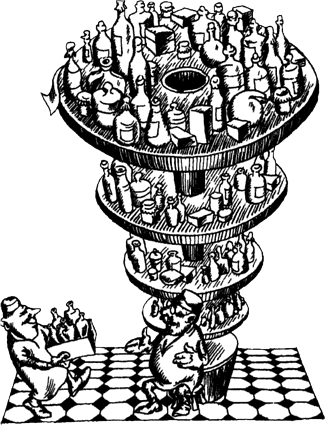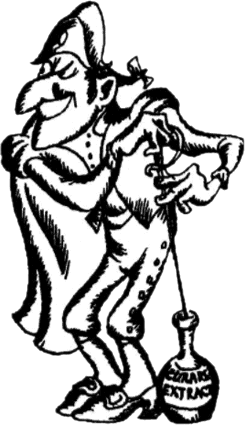107Stories About ChemistryINDEX |
98.
Chemistry in a White Smock
He bore the pompous name of Johann Bombastus Theophrastus Paracelsus von Hohenheim. Paracelsus was not his surname but a nickname meaning �better than Celsus.� Paracelsus was an excellent chemist and rumoured to be a wizard at healing, because he was not only a chemist but a physician as well. The union between chemistry and medicine consolidated in the middle ages. Chemistry had not yet won the right to be called a science. Its views were too vague and its efforts disseminated in the vain search for the notorious philosopher�s stone. But while floundering in the meshes of mysticism chemists learnt to cure serious ailments. So was born iatrochemistry, or medical chemistry. In the sixteenth, seventeenth and eighteenth centuries many chemists were called apothecaries, or pharmaceutists, though what they did in preparing various curatives was pure chemistry. True, they prepared them by hit-or-miss methods, and their �medicines� were not always beneficial to the patient.  Paracelsus was one of the most prominent �pharmaceutists�. The list of his medicines included mercurial and sulphur ointments (used to this day, incidentally, for treating skin diseases), iron and antimony salts, and various plant juices. At first chemistry could supply physicians only with substances found in nature and the assortment was very limited. But medicine could not content itself with this. Looking through a modern prescription handbook we find that only 25 per cent of the medicines are what we would call natural preparations. They include extracts, infusions, and decoctions prepared from various plants. All the rest are synthetic medicinals unknown to nature, substances created by the might of chemistry. The first synthetic medicinal was prepared about 100 years ago. The curative properties of salicylic acid for rheumatism had been known of long before. But it was very difficult and expensive to prepare from vegetable raw materials. Only in 1874 was a simple method developed for preparing salicylic acid from phenol. This acid now forms the basis of many medicinal preparations, one of the best known being aspirin. As a rule the �lifetime� of a medicine is rather short: old medicines are replaced by new ones, more perfect and better adapted to cure various ailments. Aspirin is a curious exception in this respect. It discloses new, previously unknown remarkable properties each year Aspirin can no longer be regarded merely as a febrifuge and analgesic: its range of applications is much wider. Another very �old� medicine known to everybody is pyramidon (date of birth 1896) Nowadays chemists synthesize several new medicines each day, medicines with a great variety of properties for curing all kinds of diseases They range from pain-relievers to curatives for psychic diseases. To cure people�no task could be nobler for chemists, but no task could be more difficult For several years the German chemist Paul Ehrlich attempted to synthesize a curative for a terrible ailment known as sleeping sickness Each synthesis achieved something, but left Ehrlich dissatisfied. Only in the 606th attempt was he successful in obtaining an effective remedy, which he called salvarsan, and tens of thousands of people were able to get cured not only from sleeping sickness, but also from another insidious disease, syphilis And in his 914th attempt Ehrlich obtained a still more powerful medicine called �neosalvarsan�. A medicine has to go a long way from the flask to the druggists� counter. Such is the law of doctoring that until a medicine has been checked and rechecked from all aspects it must not be recommended for use. Failure to follow this rule may lead to tragic mishaps. Not long ago a West German pharmaceutical firm advertized a new soporific called thalidomide, a tiny white tablet which could plunge a person rapidly into a deep sleep, though he suffered from stable insomnia. Thalidomide was praised to the skies but it turned out to be a terrible enemy to unborn babies. Tens of thousands of freaks�such was the price paid for putting a medicine on sale without carefully checking it. That is why it is important for chemists and physicians to know not only that a certain medicine can cure such and such a disease, but to have a good idea of how it works, of the fine chemical mechanism of its struggle with the disease. Here is a little example The derivatives of what is known as barbituric acid are not infrequently used at present as soporifics. This acid is a compound of carbon, hydrogen, nitrogen and oxygen atoms. Besides, one of its carbon atoms has two alkyl groups attached to it, these being hydrocarbon molecules deprived of one of their hydrogen atoms. Now chemists have found that barbituric acid is soporific only if it has not less than four carbon atoms in its alkyl groups, and that the larger the number of these carbon atoms the longer and more rapid is the action of the preparation. The deeper scientists penetrate into the nature of diseases, the more thorough the investigations carried out by chemists. And pharmacology, whose task was formerly only to prepare various medicines and to recommend their use for various diseases, is now becoming more and more an exact science. The present-day pharmacologist must be chemist, biologist, physician and biochemist all in one, so that no thalidomide tragedies should ever occur again. The synthesis of medicinals is one of the main achievements of chemists, the creators of a new nature. ... At the turn of our century chemists were putting a great deal of effort into the preparation of new dyes. The starting product they used was sulphanilic acid. Its molecule is very �flexible,� i.e., capable of various kinds of rearrangements. And so, reasoned the chemists, under certain conditions the sulphanilic acid molecule can be transformed into the molecule of a valuable dye. And that is exactly what happened. But until 1935 it never occurred to anyone that synthetic sulphanilic dyes were simultaneously potent medicines. The search for dyes faded into the background and chemists began to hunt for new medicinals which received the general name of sulphonamides. Some of the more common ones are: sulphapyridine, streptocid, sulphamethylthiazole, and sulphamezathine. The sulphonamides are one of the most important groups of chemical antibacterial compounds.  ... South American Indians used to make a deadly arrow poison called curare from the woody vine strychnos toxifera. An arrow dipped in curare would cause instant death if it hit the enemy. Why? To answer this question chemists had to get a good insight into the secret of the poison. They found that the main active principle of curare is the alkaloid tubocurarine. When it gets into the organism, the muscles lose their ability to contract and become immobile. Respiration becomes impossible and this causes death. However, under certain conditions this poison may be beneficial. It can be used by surgeons in carrying out certain very complicated operations. It is employed, for example, during heart operations to relax the respiratory muscles when switching the organism to artificial respiration. Thus a mortal enemy has become a friend. Tubocurarine is coming into clinical practice. But it is still too expensive, and a cheaper and more available preparation is needed. Once again the chemists chimed in. They studied the tubocurarine molecule from all aspects, split it in various ways and investigated the resulting �fragments.� Step by step they disclosed the relation between the chemical constitution and the physiological activity of the preparation. They found that its action was due to certain groups containing positively charged nitrogen atoms, and that there must be a strictly definite distance between these groups. Now the chemists could get down to the task of imitating nature and trying to excel it. First they obtained a preparation which was no less active than tubocurarine, and then began to improve it. The result was Syncurine, a preparation twice as active as tubocurarine. Another vivid example has to do with malaria. The remedy for this disease used to be quinine, a natural alkaloid. But chemists were able to produce a substance sixty times as active as quinine. This substance is pamaquin, otherwise known as plasmoquine. Present-day medicine has at its disposal an immense arsenal of remedies, one may say, for all occasions, and for almost all known diseases. There are very potent remedies for tranquilizing the nervous system, which calm down even the most irritated person. There is a preparation which completely eliminates fright. Of course, it would be useless to a student in fear of taking his examination. There is a whole group of medicines known as sedatives which allay irritation. One of them is reserpine, used at one time extensively for treating certain psychic disorders (schizophrenia). Chemotherapy is now the cardinal method of treating mental disorders. But not always have the achievements of medicinal chemistry born only positive fruit. There is, for instance, such an ominous (one could hardly call it anything else) remedy as LSD-25. In many capitalist countries it is used as a narcotic which artificially causes the very symptoms of schizophrenia (all kinds of hallucinations enabling one to forget for a time the �difficulties of life�). But there have been no few cases where people who took LSD-25 tablets never regained their normal state. According to present-day statistics the majority of deaths in the world are due to myocardial infarctions (heart strokes) or cerebral apoplexy. Chemists are helping to fight these maladies by inventing various cardiacs and medicines for expanding cerebral vessels. Thanks to tubazid and para-aminosalicylic acid (PASA), two more medicines synthesized by chemists, physicians can now conquer tuberculosis in the great majority of cases. Finally, scientists are putting great efforts into the search for remedies for cancer, this awful scourge of the human race. There are still very many obscurities in this field and it offers much room for investigation. Physicians await new miraculous substances to be provided by chemists. Nor do they await them in vain there is no doubt that in this field chemistry will make as good a show as elsewhere |





